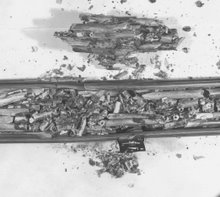The following is copied from my original blog, http://nuclearenergyblog.blogspot.com/
February 24, 2007
Suppose I had false memories
Of course, one has to be careful about swearing to the truth of lots of stuff. What if I had an imagination, or far worse, some Orwellian false memories? My first entry in this blog briefly mentions the SL-1 explosion and that is pure documented fact.So let us suppose that near the west coast there was a nuclear test reactor of sorts. And the downtown office sends a front man to Idaho to attend some SL-1 explosion briefings. Upon his return, if he went, he comes out in the country and gives us a sanitized briefing at the reactor of sorts (ROS).
He describes the central control rod at SL-1 and before he gets to his next sentence, a sneering commenter might have bellowed out, "It would take a team from Argonne to put a control rod right in the center of that core."
Now we can move ahead a few years. The ROS might have been built with control rods that used boron stainless as structural material as well as poison. The control rod structure could have cracked after moderate use, leading to binding and other bad scenes. So, a cadmium assembly could have been designed that would have superior life and equivalent control strength (with thermal neutrons, black is black).
For a bit of further background, the ROS might have had six control rod assemblies with fuel followers, and if these assemblies existed, they were similar to the assemblies of the Engineering Test Reactor ETR that was in Idaho. The ETR poison sections were about three feet long and they included fuel followers so that fuel was added to the control rod location as control rods were withdrawn.
So, a new cadmium assembly might have been built, but how to test it for worth? The easiest thing would be to place it in the very center position of the ROS, go critical, shut down, remove it, and replace it with an old boron assembly and go critical again. Then a comparison of the positions of criticality would be a great proof test.But there might have been a restriction on such a procedure because the amount of reactivity (plus or minus) that was allowed in the center of ROS might have been limited by its operating license, if it had such.
However, under an AEC rule, 50.59, it might have been stipulated that the restriction on reactivity only applied to long term operations and not a simple field test of only several minutes at the most. So, such a comparison might have proceeded. And if it did proceed, the sneering commentator of the second paragraph above might have had the task of predicting the amount of withdrawal of the six control rods that would yield criticality. And if such a prediction was made, it might have been that criticality would be reached with about half of full withdrawal, about 18 inches.If the test proceeded, it might have been found that criticality was not reached as predicted. And then a guy in the control room might have telephoned the sneering commentator (who could have been elsewhere). The sneering commentator might have provided assurance that the situation was no big deal, that with such an unusual geometry with such a vast amount of poison in the most reactive location in the core, an accurate prediction was likely out of the question.So, the test may have proceeded. And if it did, the careful slow withdrawal of the bank of six control rods might have proceeded with several stops along the way to criticality. And criticality might have been reached with the gang withdrawal at 33 inches out of the maximum 36 inches that was possible with the ETR design. And that would have been very interesting since fuel followers would have added to the reactivity worth of the center of the core. And if the test had proceeded it might have been found that the cadmium section also led to 33 inches of gang withdrawal. After all, black is black.
And so, if in the game of inserting the control rod in location E-5, going critical, shutting down, removing the control rod, placing the new design, going critical, shutting down, removing the new design; if, then it might have been very fortunate that nothing happened that would have made SL-1 look like a ladyfinger.* And maybe, in contrast to SL-1, the ROS, in my wildest false memory could have had targets for isotope production, like cobalt stuff.
*During the mid 1930s, if a kid could get his money onto the counter, he could buy firecrackers. If he saved up, he could buy three ten inchers for a dime. For a nickel he could by a package of zillions of ladyfingers. Ladyfingers were weak little things that would damage nothing even if held held between the kid's fingers.
Friday, June 1, 2007
Subscribe to:
Post Comments (Atom)

No comments:
Post a Comment